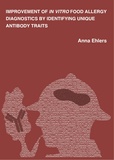Improvement of in vitro food allergy diagnostics by indentifying unique antibody traits

Ehlers, Anna
- Promoter:
- Prof. dr. A.C. (André) Knulst
- Co-promoter:
- Dr. H.G. (Henny) Otten
- Research group:
- Knulst
- Date:
- February 18, 2021
- Time:
- 10:30 h
Summary
To avoid unnecessary food restrictions of patients with a suspected food allergy, accurate diagnostics are key. Measurement of antibodies in the blood, specific IgE (sIgE) in case of allergies, is a commonly used method to determine whether the immune system reacts to a particular protein (allergen) in the food. Because sIgE measurements can be “false-negative” (negative test despite allergy) and “false-positive” (positive test despite tolerance), burdensome food challenges are still the gold standard for diagnosising food allergies. With a view to prevent false-negative and false-positive sIgE test results, we studied traits of patients’ IgE antibodies.
False-negative results can be reduced by identifying responsible allergens that are not yet available for sIgE measurements in clinical practice. In macadamia nut allergy, a newly identified macadamia nut allergen was particularly recognized by sIgE from patients with severe symptoms, supporting discrimination between mild and severe macadamia nut allergy.
False-positive results can be reduced by identifying specific binding sites of the allergen that are only recognized by sIgE of allergic patients. In this regard, sIgE binding to binding sites of the hen’s egg allergen Gal d 1 was able to discriminate between hen’s egg allergic and tolerant adults, while sIgE binding to the whole allergen was not. Besides binding characteristics, antibody differences at DNA level have the potential to discriminate between peanut allergic and peanut tolerant patients with a positive sIgE test result.
These unique antibody traits provide the fundament for the development of improved, minimally invasive food allergy diagnostics, which will decrease patients’ burden by reducing the need for cumbersome food challenges in the future.